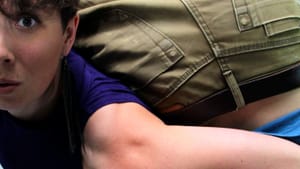Stay in the Loop
BSR publishes on a weekly schedule, with an email newsletter every Wednesday and Thursday morning. There’s no paywall, and subscribing is always free.
The lies we tell
Fringe Festival: RealLivePeople's 'Would I Lie to You?'

In solo, partner, and group pieces, the eight dancers of RealLivePeople slid, kicked, rolled, leapt, and spun around the floor. Their motions, like the overall tone of Would I Lie to You?, were sharp yet graceful, dynamic yet playful. There were clean lines and enough breaking of form to vary the patterns made. Most of the movement included body contact and weight sharing between the dancers, suggesting the way that lies can weigh on and entangle our relations.
White, gauzy strips of curtain hung from the ceiling to the floor, obscuring and accenting interactions among the dancers. The dancers would push and pull the curtains in different positions before and after each performance, evoking the manipulation and hunger for control built into the act of lying. The curtains represented material that lies might change.
The curtains sectioned off the stage, and different styles of performance broke the show into different parts. Most of the show consisted of choreographed dances. Ad-libbed statements guided improvisational movement in other parts: True statements advanced the pair across the floor, while false statements sent them backward. Additional segments were improvisational skits using the lies the audience supplied on Post-it notes prior to the show’s beginning. Interspersed with music were the voices of interview subjects — including the cast themselves — talking about lies they’ve told and lies they’ve been told.
While the show as a whole tended to feel disjointed at times, the multilayered approach held my attention. The use of words (spoken by dancers, written on Post-its, or recorded and played aloud), as well as the dancers’ facial expressions, made the performance more accessible and enjoyable to those who do not consider themselves privy to the nuances of contemporary dance. The different kinds of performances within the show raised complex questions about the nature of lies. Was the show itself a lie, with each dancer merely performing for us? Is this any different from how we perform for each other on a daily basis (cue affect theory and some Judith Butler)? Did the improv parts consist of lies made up on the spot, or did the lack of rehearsal make them more true — or if not more true, than perhaps more authentic? Would anything have changed if we considered the actions to be something different than what they were?
Would I Lie to You? makes the case that lying brings us together as much as it separates us from one another. The show’s tagline is: “You’re a liar. So are we.” Not accusatory, not condemning, not condoning, just a matter of fact. As the show progressed, the dancers shed layers of clothes, ending the performance stripped down to their underwear, possibly daring the audience to judge them. The naked truth was at the heart of the show, and yet the cast was still dancing around lies.
Being a liar isn’t exceptional. In fact, it’s all too relatable: Audience members could easily recognize lies featured in the show as well as the situations and motives that led to those lies. The show explores lies of all types, both explicit and implicit: lies we tell ourselves (“My work is important”), lies to get out of situations (“I’m busy tonight, can’t go to your event”), lies of etiquette (“I love seeing pictures of your baby on Facebook”), and lies so common we may have stopped regarding them as lies altogether (“You are a valued employee” or “I’m fine”). Would I Lie to You? doesn’t seek to vilify liars. If anything, being a liar is endearing, and liars, in the framework of the show, earn our empathy. Lies reveal truths — about the liars themselves, whatever the lie conceals, and human nature. The flickers of truth in lies mean that lying is a habit that Would I Lie to You? doesn’t ask you to break.
What, When, Where
Would I Lie to You? RealLivePeople. Fringe Festival production at the Latvian Society, 531 North 7th Street, Philadelphia, September 5 through 10. http://www.reallivepeople.org/
Sign up for our newsletter
All of the week's new articles, all in one place. Sign up for the free weekly BSR newsletters, and don't miss a conversation.